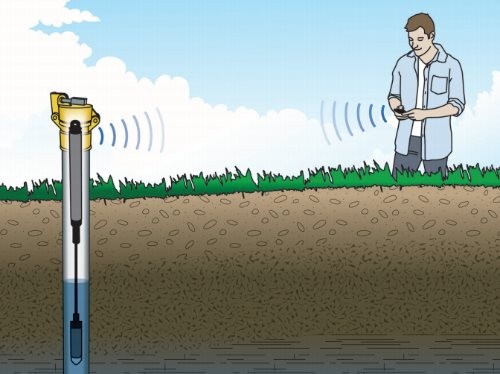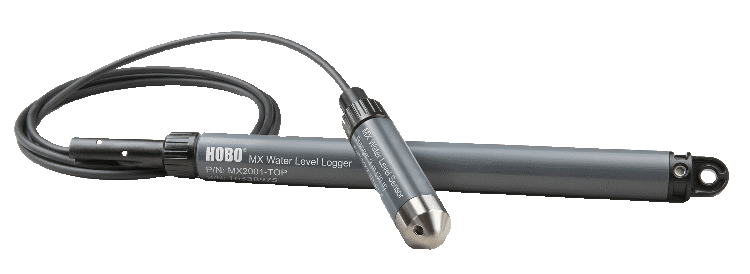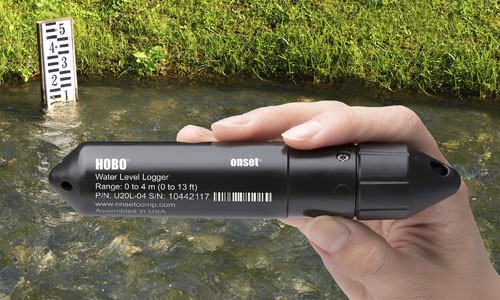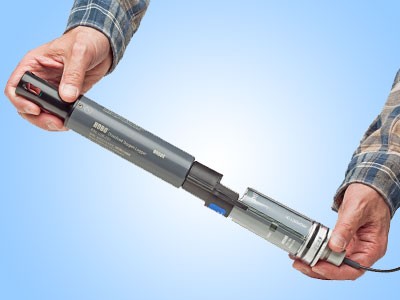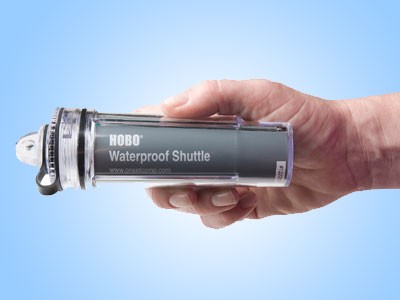HOBO Water Level Data Loggers for level recordings
Choose from a variety of data loggers for recording water level and temperature in groundwater wells, streams, lakes, wetlands and tidal areas. Our HOBO Water Level Loggers are high-accuracy, pressure-based water level recording devices. They combine accuracy and durability with an attractive price, typically only found in research-grade products. The systems are roughly only half the cost of most comparable solutions.
Versatile monitoring solution for water parameters: The HOBO MX800 wireless data loggers
The HOBO MX800 series of wireless multi-parameter data loggers offer a versatile and customizable solution for monitoring conductivity/salinity, temperature, depth and dissolved oxygen in water. Thanks to the interchangeable sensors, these data loggers can be used flexibly. The series comprises two models: the MX801, a fully submersible and easy-to-install model, and the MX802, which enables direct readout without the need to remove the sensors from the water.

Bluetooth Water Level Data Logger - HOBO MX2001
Dhe HOBO MX2001 is a water level data logger to leverage Bluetooth Low Energy as a user-friendly method for wireless configuration and evaluation of measurements.
This allows you to conveniently read high-precision measurement data such as absolute pressure, atmospheric pressure, differential pressure, water level and water temperature during field deployment using a mobile phone or tablet. The cable lengths for the water level sensor range from 0.2 to 500 meters, enabling it to be used in a wide range of different bodies of water, right through to the use in the ocean.Monitoring of the water level via Bluetooth:
- Wireless data transfer to mobile devices via Bluetooth Low Energy (BLE)
- Integrated atmospheric pressure sensor allows direct readout of the water level
- Reference water level can be set at the beginning of the operation
- Different types of recording: Standard, Multi-Interval and Burst Modes
- Long-life ceramic sensor
- Level sensor available in both stainless steel and titanium versions
- +
Technical Data and Documentations
Technical Data
Parameters Pressure, water level Measurement Range 0 to 850 kPa; approx. 0 to 76.5 m water depth at sea level, or 0 to 79.5 m at 3,000 m altitude Environment Underwater Water depth depending on the device Level difference 4 meter level difference
9 meter level difference
30 meter level difference
76 meter level differenceBattery life 1 year with typical use
Battery user replaceableDocumenations
Requirements
- HOBOconnect Software
- PC, Laptop
Water Level Loggers in an Attractively Priced Plastic Housing - HOBO U20L-xx
The HOBO devices of the U20L series are inexpensive, professional data loggers for the continuous measurement of water level and temperature in a variety of applications. They offer 0.1% measurement accuracy, a polypropylene housing for use in both fresh and saltwater, and a design that does not require venting, making it convenient and easy to use.
Please note: An interface is required for configuration and reporting
Cost-effective recording of water levels:
- Self-sufficient design without vent pipe allows maintenance-free use
- Level measurement in fresh and salt water, including wells, streams, lakes, wetlands and mudflats
- Durable ceramic pressure sensor also withstands freezing temperatures
- HOBOware Pro software enables easy conversion to accurate water level data, with full compensation for barometric pressure, temperature and water tightness
- +
Technical Data and Documentations
Technical Data
Monitoring Parameters Absolute pressure, atmospheric pressure, water level and water temperature. Measurement Range -20 °C to +50 °C Environment Outdoors and underwater (fresh and saltwater) Models Water depth up to 4 meters: U20L-04
Water depth up to 9 meters: U20L-01
Water depth up to 30 meters: U20L-02
Literature and Videos
Instructions for Barometric Compensation
Requirements
- HOBOware Software (click here for software download)
- PC, Laptop
Water Level Loggers in a Rugged Stainless Steel Housing - Hobo U20-001
The HOBO Stainless Steel Water Level data loggers feature highest accuracy at a great price and shine through their ease-of-use, with no cumbersome vent tubes or desiccants to maintain. These data loggers are ideal for recording water levels and temperatures in shallow wells, streams, lakes and freshwater wetlands.
Please note: An interface is required for configuration and reporting
- +
Technical Data and Documenations
ModelleU20-001-04 Water depth up to 4 meters U20-001-01 Water depth up to 9 meters U20-001-02 Water depth up to 30 meters U20-001-03 Water depth up to 75 meters Technical Data
Monitoring Parameters Absolute pressure, atmospheric pressure, water level and water temperature. Measurement Range -20 °C to +50 °C Environment Outdoors and underwater (freshwater)
Documenations
Instructions for Barometric Compensation
Requirements
- HOBOware Software (click here for software download)
- (PC, Laptop
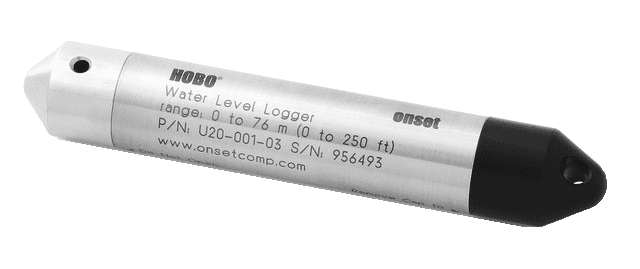
HOBO Water Level Data Logger U20-001-03
Water Level Loggers in a robust Titanium Housing - Hobo U20-001-Ti
The HOBO Water Level Titanium data loggers are recommended for saltwater deployment for recording water levels and temperatures in wetlands and tidal areas. These data loggers feature highest accuracy at a great price and HOBO ease-of-use, with no cumbersome vent tubes or desiccants to maintain.
Please note: An interface is required for configuration and reporting
- +
Technical Data and Documentations
Modelle
U20-001-04-Ti Water depth up to 4 meters U20-001-01-Ti Water depth up to 9 meters U20-001-02-Ti Water depth up to 30 meters U20-001-03-Ti Water depth up to 75 meters Technical Data
Parameters Absolute pressure, atmospheric pressure, water level and water temperature. Measurement Range -20 °C to +50 °C Environment Outdoors and underwater (including in saltwater) For detailed product specifications, see the User’s Guide (below).
Literature and Videos
Instructions for Barometric Compensation
User's Guide HOBO U20-001-0X-Ti
Requirements
- HOBOware Software (click here for free software download)
- PC, Laptop

HOBO Data Logger U20-001-0X-Ti
- Lightning protection - no long signal wires, and electronics are shielded in a titanium housing for use in saltwater
- HOBOware Pro software enables easy conversion to accurate water level data, with full compensation for barometric pressure, temperature and water tightness
- Multiple-rate sampling allows faster sampling at critical times such as when pumping starts or stops.
- Available in 4 depth ranges
- No-vent-tube design for easy reliable deployment
- Durable ceramic pressure sensor
- 3-point NIST-traceable calibration certificate included
Universal Optic Base station - BASE-U-4
The Universal Optic USB Base Station and couplers are used to offload data from any HOBO® data logger with an Optic USB interface. The splash-resistant Optic USB Base Station connects to your computer via USB, while connecting to the data logger via an appropriate coupler. The base station is compatible with the HOBO UA, U20, U22, U23, UTBI, U24 & U26 series.
HOBO Waterproof Shuttle - HOBO U-DTW-1
The HOBO Waterproof Shuttle provides convenient readout and relaunching of underwater and outdoor HOBO data loggers with an Optic USB interface, and is waterproof to 20m. The HOBO Waterproof Shuttle can also be used as a base station.
Note 1: Couplers are included for compatibility with our U-series loggers with optical communication, including the UA Pendants, U20 water level, U22 Water Temp Pro, UTBI TidbiT, U23 Pro Temp/RH, U24 Conductivity and U26 DO data loggers.
Note 2: HOBOware Pro is required when using the U-DTW-1 Waterproof shuttle.
Webinar - the right water level logger for your demands
HOBO water level loggers offer 0.1% range accuracy of 4, 9 and 30 meters and up to 0.14 centimeter resolution. Unlike conventional water level recorders that must rely on cumbersome vent pipes and desiccants, HOBO water level loggers operate as self-contained devices. This simplifies deployment and eliminates many of the maintenance issues associated with using vent pipes. If necessary, a second HOBO water level logger can be used for air pressure compensation. The HOBO U20L Series sets a new standard for price/performance ratio for monitoring water level and temperature. The loggers combine 0.1% measurement accuracy with a rugged housing that does not rely on venting for trouble-free operation.Choosing a conductivity logger
With the increasing demand for water resources, it is more important than ever to be able to assess the impact of urban development and agriculture on water resources. To meet this growing demand, water resource managers, engineers, and hydrologists must monitor groundwater and surface water levels with water level data loggers to document baseline and changing water levels over time.
Conductivity loggers incorporate a built-in microprocessor, sensor, and battery in a rugged enclosure designed for long-term underwater deployment. They can be deployed and left unattended for days, weeks, or months at a time, collecting data at user-defined intervals and storing it digitally into logger memory. By operating in a continuous monitoring mode, conductivity loggers eliminate many of the hassles of manual data collection approaches and facilitate simultaneous monitoring of multiple locations.
Water level loggers also automate the archiving process and reporting of data. Hydrologists can easily transfer logger data to a mobile device or computer and create detailed graphs or files. Charts can be easily printed for documentation purposes, while electronic data can be archived or exported to other programs.
Although the water level logger is becoming the tool of choice for more and more hydrologists when it comes to data collection, the myriad of products on the market can make it difficult to choose the right product for the application. Whether you have experience with water level measurement or are just getting started, this report will help you choose the right products for your needs. It points out the five most important considerations and provides tips on specific functional feature
Webinar: Which water level recording solution is best for you?
Want to easily record or accurately monitor water levels of lakes, rivers, wetlands, estuaries or other application areas? Learn more about configuration, placement, data analysis of web-enabled, bluetooth or stand-alone loggers.
Webinar topics:
- Connection types
- Software options
- Power supply
- Sensors
- ...and more!
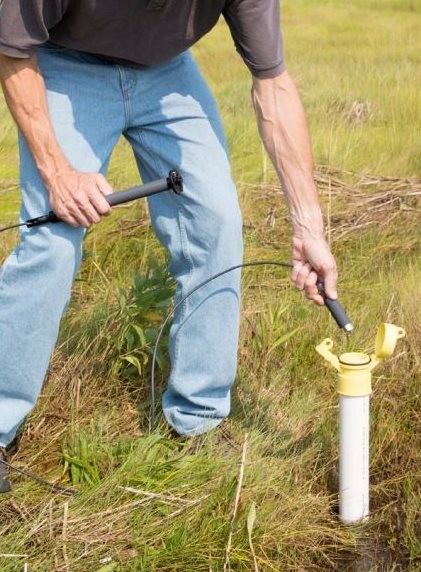
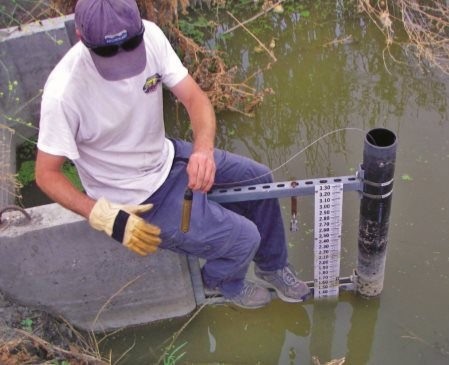
1. Barometric Compensation
Vented and non-vented
Vented loggers include a built-in vent tube that enables the loggers to automatically compensate for atmospheric pressure changes. By equalizing these changes on both sides of the pressure sensor, a well-designed and maintained vented water level logger can provide high-accuracy water level data.
Non vented loggers do not use vent tubes. Instead, these loggers can be barometrically compensated using a barometric pressure logger and a simple software function to perform the mathematics. Barometric pressure values can also be obtained from weather stations within a 10-mile radius.
Now there is also a type of non-vented logger that incorporates both an in-water sensor and a barometric pressure sensor.
Keep in mind that while vented loggers have the potential to provide the greatest accuracy, they also have a number of limitations that can cause problems and result in bad data and/or data loss. These limitations include:
- Vented loggers are bulkier than non-vented loggers, which makes them more difficult to transport and deploy.
- Most vented loggers require the use of desiccants for moisture protection, which increases the amount of maintenance that's required and therefore the total cost of ownership of the logger. And condensation buildup can lead to accuracy problems.
- When monitoring water containing contaminants, vent tubes with contaminant-resistant material must be used, which adds to the cost of the logger, as does the decontamination process that is required before the logger can be redeployed
- Vented loggers lack flexibility when it comes to deploying them at various depths. Cables cannot be lengthened without sending them back to the supplier, and shortening required delicately coiling the cable without creating any kinks.
- If the end of the vented logger cable is inundated by rising water, all subsequent data are compromised due to unknown pressure compensation dynamics during the flood event.
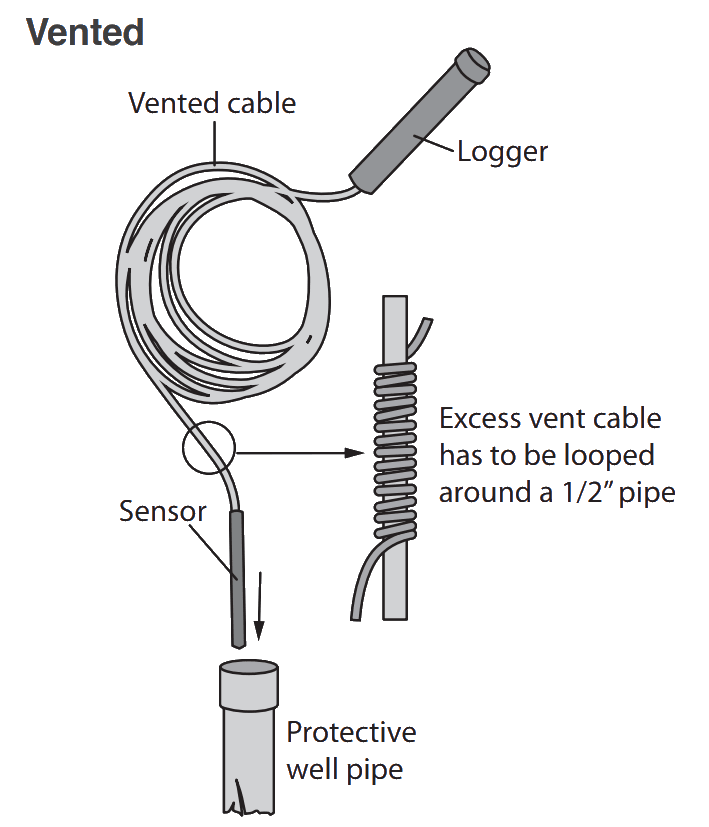
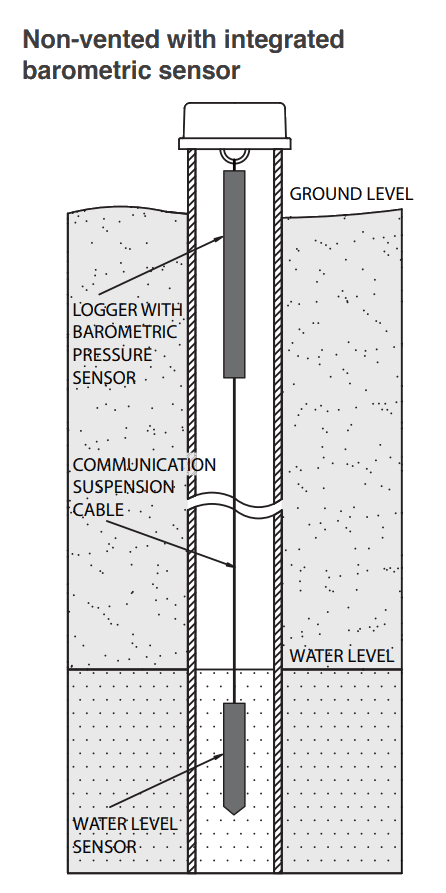
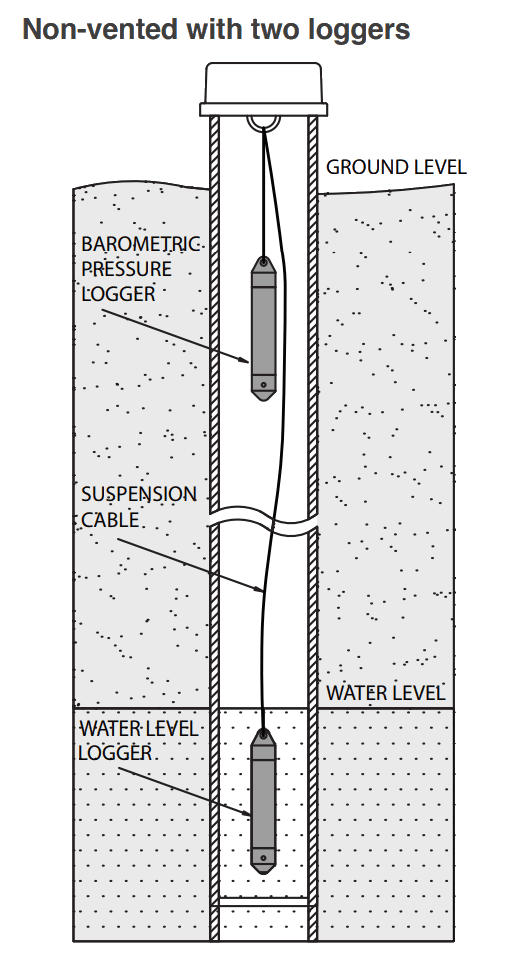
2. Understanding Accuracy
When evaluating water level accuracy, you will want answers to the following questions:- What is the system-level accuracy? For non-vented loggers, the system accuracy is the sum of the water level loggers error plus the barometric pressure loggers error. The barometric pressure error is often overlooked but needs to be included. On the other hand, vented water level loggers or sensors are measuring the differential pressure directly, so there is just the one sensor measurement error to include.
- Does the accuracy specified relate only to the logger's sensor or to the entire logger? A water level loggers sensor and analogue-to-digital (ADC) converter both contributes to error. The error from the ADC can be just as significant as sensor error. For this reason, you will want to confirm with the manufacturer that the specified accuracy refers to the entire measurement rather than just the sensor. To realize a 0.01-foot water level resolution required at least a 12-bit ADC with a 30 psi water level sensor. Likewise, you should make sure the barometric logger's accuracy specification includes all sources of error.
- Does the accuracy specification apply across the full-calibrated measurement range of the logger? The accuracy a water level logger can achieve at the high or low end of a given range may be far different from the accuracy at the middle of the range. For this reason, it’s important to find out if the logger’s accuracy specification refers to a single point or the entire measurement range. Knowing the full-range accuracy of a water level logger will give you assurance that the logger will meet your accuracy requirements.
- Do temperature variations cause additional error outside of the accuracy spec? Some water level loggers are not able to effectively compensate for temperature changes, which cause incorrect pressure readings. For this reason, it’s important to find out if the error that results from temperature changes is included in the accuracy specification, or if there is a separate error term that must be added. Data loggers with reduced overall mass will equilibrate more quickly to changing temperature conditions to increase dynamic response during changing conditions. The response-time specifications will indicate how quickly the logger will equilibrate
- Is drift important? The pressure sensors in water level loggers will drift over time. Whether or not you need to be concerned about drift depends on your
application. Drift is important in cases when absolute pressure values are needed, or if there are no recent reference level or depth measurements available. This may be the case if a water level logger is deployed for more than one year and no reference-level readings are taken during that deployment. Otherwise, drift is not a significant factor since it will be offset by regular (i.e. monthly) manual reference-level readings. Regardless of whether drift will affect your data, it is a good idea to ask the logger manufacturer for drift specifications.
3. Software features that really matter
Just as water level loggers can vary considerably from model to model, so too can the graphing & analysis software or app that accompanies them. From a general standpoint, it’s a good idea to look for something that’s highly intuitive, so the learning curve is minimal. You’ll also want to be able to quickly and easily perform tasks such as configuring loggers, and moffloading, graphing, and sharing data.
The software features you’ll want to consider depend on where the software is being used. For software being used in the field, look for capabilities related to deploying loggers and offloading data. For software being used to analyze data in your office, look for more powerful analysis capabilities.
In terms of specific features, here are some you’ll want to consider, depending on where you will be using it:- Time-saving launch features – If you will be launching many loggers at once, look for software that allows you to configure the logging parameters once, and then use those settings to configure all of the loggers for the deployment. Not only does this save time, but it also helps to ensure that all loggers are configured the same. For example, you may want to configure a group of loggers to all start at the same time and with the same logging rate.
- Barometric compensation (for loggers that don’t include integrated barometric pressure compensation) – To convert a non-vented logger’s pressure readings to barometrically-corrected water level values, make sure the logger software has a barometric compensation utility. These tools typically allow you to enter reference level, water density, and other values into a dialogue box, and then automatically perform the pressure-to-water level conversion.
- Multi-logger graphing – When monitoring water levels at multiple sites, it is often advantageous to be able to view and analyze data from each water level logger on a single graph. Be sure to ask the manufacturer about this capability.
- Easy data export – Because water level data often needs to be incorporated into other software programs, such as spreadsheets or modelling programs, make sure you’re able to quickly and easily export data in a range of data formats.
- Project save and recall – While the ability to save and recall projects may seem like a basic feature of any logger software package, the reality is that many do not support this capability. Since data analysis typically involves a number of steps, including merging multiple data files together, converting pressure readings to water level units, and formatting charts, you’ll want to be sure that the logger’s software allows you to save your work so you can easily recall it and add to it in the future.
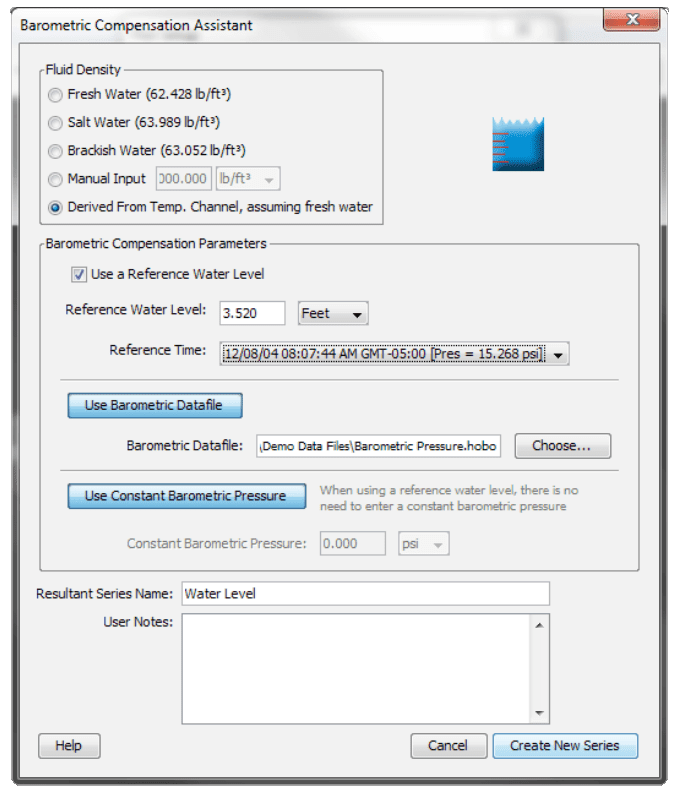
HOBOware’s Assistent für barometrische Kompensation
4. Buying vs. renting
In the past, the relatively high price of water level loggers has prevented many hydrologists from purchasing their own supply of loggers. Many have chosen to rent loggers instead. While renting can be a convenient option for short-term deployments, it is important to be aware that the price of water level loggers has decreased to the point where purchasing is more cost-effective for many applications. If you provide hydrology or groundwater services, owning an inventory of water level loggers may give you a competitive edge, since you’ll be able to waive additional equipment rental fees for your customers.
5. Connecting to the Logger
Data loggers with a wireless connection to a mobile device offer the convenience of not having to take a laptop into the field, while still being able to view data and change configuration settings in the field if needed. Wireless loggers with Bluetooth Low Energy (BLE) technology provide the additional benefit of not having to physically access the logger to push a button to activate communication, as earlier versions of Bluetooth require. Loggers that rely on mechanical plug-in connectors can be damaged by water in the field and cause logger failures. Water level loggers with an optical interface that is completely sealed within the logger’s housing eliminate the possibility of water-related damage and/or failures. For loggers with an optical interface, you will need an optical base station to connect the logger to a computer. The best option for connecting to the computer is a direct USB interface. Some older loggers use serial communications to the logger and use a serial-to-USB converter to allow them to be connected to USB. Because the loggers still are using serial communications internally, their data offload speeds are limited to the slower serial speeds, and they require special drivers to be installed on the computer.
